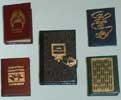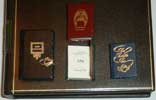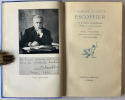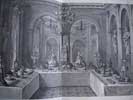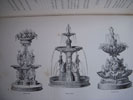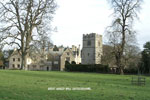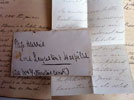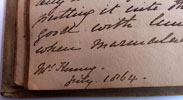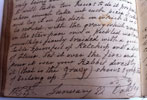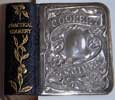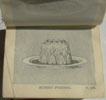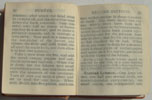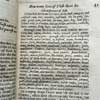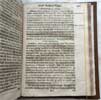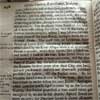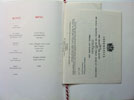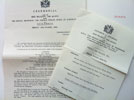Royal Menu
- From Osborne House.
Her Majesty Queen Victoria's Dinner
Dated Monday August 29th, 1900.
225 x 140mm. Thick cardboard. Handwritten in ink in a neat script. The menu and the border are very bright. The edges are rubbed and slightly spotted and browned. Overall slightly age browned. Housed in a marbled cardboard folder with a label on the front cover. Overall a very nice item of very rare Royal ephemera. Queen Victoria died on January 21st 1901. Her Majesty had this dinner 5 months before.
-
Osborne House is a former royal residence in East Cowes, Isle of Wight. The house and its 800 hectare estate was bought from Lady Isabella Blachford in 1845, demolished, and a new house built by 1851 as a summer retreat for Queen Victoria and Prince Albert.
Prince Albert designed the house himself in the style of an Italian Renaissance palazzo. The builder was Thomas Cubitt, the London architect and builder whose company built the main façade of Buckingham Palace for the royal couple in 1847. At Osborne an earlier smaller house on the site was demolished to make way for the new and far larger house.
Queen Victoria died at Osborne House in January of 1901. Following her death, the house became surplus to royal requirements and was given to the state with a few rooms retained as a private royal museum dedicated to Queen Victoria. From 1903 until 1921 it was used as a junior officer training college for the Royal Navy known as the Royal Naval College, Osborne. Today it is fully open to the public. The house consisted of the original square wing known as 'The Pavilion', which contained the principal and royal apartments. The apartments contain reminders of Victoria's dynastic links with the other European royal families. The Billiard Room houses a massive porcelain vase, which was a gift of the Russian Tsar. The grandeur of the Billiard Room, the Queen's Dining Room and the Drawing Room on the ground floor forms a marked contrast with the much more homely and unassuming decor of the royal apartments on the first floor. These rooms contain the Prince's Dressing Room, the Queen's Sitting Room, the Queen's Bedroom and the children's nurseries, which were intended for private domestic use, and were therefore arranged to be as comfortable as possible. Both Queen Victoria and Prince Albert were determined to bring up their children in as natural and loving environment as their situation allowed so that as a consequence the royal children visited their parents' bedrooms when other children of a similar status lived in a far more detached manner.
The 'main wing', containing the household accommodation, council and audience chambers were added later. The final addition to the house was a wing built between 1890 and 1891. It contains on the ground floor the famous Durbar Room which is named after an anglicised version of the Hindi word darbar. This word means court. The Durbar Room was built for state functions and decorated by Bhai Ram Singh in an elaborate and intricate style, with a carpet from Agra. It now contains the gifts Queen Victoria received on her Golden and Diamond Jubilees. These include engraved silver and copper vases, Indian armour and even a model of an Indian palace. The Indian associations of Osborne House also include a collection of paintings of Indian persons and scenes, painted at Queen Victoria's request by Rudolf Swoboda. There are both depictions of Indians resident or visiting Britain in the 19th Century and scenes painted in India itself when the painter went there for the purpose. The first floor of the new wing was for the sole use of Princess Beatrice and her family. Beatrice was the Queen's youngest daughter, who remained permanently at her side.
The royal family stayed at Osborne for lengthy periods each year: in the spring for Victoria's birthday in May; in July and August when they celebrated Albert's birthday; and just before Christmas. In a break from the past, Queen Victoria and Prince Albert allowed photographers and painters to capture their family in the grounds and in the house, partly for their own enjoyment and partly as a form of propaganda for the nation to show what a happy and devoted family they were. Many thousands of prints of the royal family were sold to the public which led Victoria to remark, "no Sovereign was ever more loved than I am, I am bold enough to say." Writing to her daughter Victoria in 1858 about the gloominess of Windsor Castle, Queen Victoria stated, "I long for our cheerful and un-palace-like rooms at Osborne."
The domestic idyll at Osborne was not to continue. In December 1861, Prince Albert died at Windsor Castle. During her widowhood, Osborne House continued as one of Queen Victoria's favourite homes.
Today, Osborne House is under the care of English Heritage and is open to the public from spring through to autumn. The former Naval College's cricket pavilion was converted into a holiday cottage in 2004 and can be booked by members of the public. Guests staying at the cottage are given the right to use the Osborne Estate's private beach.
Photographs 4 and 5 below show Osborne House as it is today. Photograph number 6 is a print of a painting in 1870 by Sir Edwin Landseer, of Queen Victoria and John Brown at Osborne. In it the Queen sits grandly on her horse while perusing state documents. On the ground are discarded documents and the Queen's gloves beside the red dispatch box. John Brown deigns not to pick them up, instead he rigidly guards the Queen's security and safety by not letting go of the horses reins. By the horse we see an amusing vignette of a small black scotch terrier on hind legs with paws together in a frozen pose of absolute devotion. The elaborate and decorous menu on offer here also gives a glimpse of the ultimate privilege of the Queen's household.

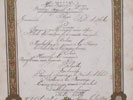
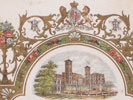
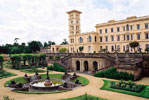
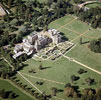
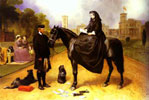
|
|

Ephemera category
ref number:
11141
|
